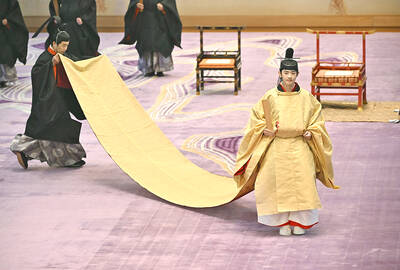On a cold night in the Gobi, a tourist van, limping on three tires and a steel rim, bounced up to a ger, the circular tent of the desert nomads.
After peering into the tent, the three young tourists asked the herdsmen inside for help. The men grouchily gave them a choice: watch the last half of a South Korean soap opera on television, or wait it out under the stars.
"They were just too busy to notice us," Khorolsuren Byambasuren, the tour guide, said here, still miffed at the memory of her mid-September mishap. "They waited until midnight, when Min Sung-yong happily met Kim In-ha, at the last part of Intrigues of the Life. Then the guys enthusiastically helped us, and we were on our way to the tourist camp at 3am."
Mongolia's ancient hospitality takes a holiday during the time slot for dubbed South Korean soap operas. With Mongolia's two main television channels showing South Korean movies daily, a giant Do Not Disturb sign goes up every evening across this sparsely populated land.
Mongolians and Koreans are ethnically related peoples cut off by centuries of history. In the 13th century, Mongolians swept across China and down the Korean Peninsula, and were on the brink of invading Japan until several naval disasters changed their minds.
Mongolia's occupation of Korea left linguistic affinities, shared genes and wild horse herds, known to this day as Mongolians, on the South Korean island of Cheju, the staging base for the frustrated invasion of Japan.
Today's bonds reflect, to some degree, the solidarity of two small nations living on the edges of a rising China. Commercially, Mongolia is an outpost for Korean business. On an ethnic level, Koreans and Mongolians are like fraternal twins.
Advertising banners here implore "UB"girls to try a cosmetics line from Seoul, Ulan Bator's new style maker. For ad campaigns in Mongolia, South Korean companies do not bother to reshoot with local models.
"It works -- our features are that similar," Byambasuren said over lunch at a sidewalk cafe.
Kim Sung-chul, a South Korean pastor who has been here three years, said, "We look the same; our skin is the same; our grammar structure is the same."
Since 1999, the year Kim Dae-jung, then South Korea's president, flew here, the Ulan Bator-Seoul route has been one of the busiest for Korean Air and Mongolian Airlines.
Remittances from Mongolians working in South Korea have become an important source of income to this nation of 2.5 million. With 20,000 Mongolians in South Korea, the country now has more Mongolians than Japan, Europe and the US combined.
While some Mongolians say they are put off by a Korean arrogance, many Koreans say the advantages are there for both sides.
"After two years, Koreans can speak Mongolian," said Kim Wan-jin, a translator.
"But it is even easier for Mongolian people to learn Korean," Kim said.

China on Monday announced its first ever sanctions against an individual Japanese lawmaker, targeting China-born Hei Seki for “spreading fallacies” on issues such as Taiwan, Hong Kong and disputed islands, prompting a protest from Tokyo. Beijing has an ongoing spat with Tokyo over islands in the East China Sea claimed by both countries, and considers foreign criticism on sensitive political topics to be acts of interference. Seki, a naturalised Japanese citizen, “spread false information, colluded with Japanese anti-China forces, and wantonly attacked and smeared China”, foreign ministry spokesman Lin Jian told reporters on Monday. “For his own selfish interests, (Seki)

VENEZUELAN ACTION: Marco Rubio said that previous US interdiction efforts have not stemmed the flow of illicit drugs into the US and that ‘blowing them up’ would US President Donald Trump on Wednesday justified a lethal military strike that his administration said was carried out a day earlier against a Venezuelan gang as a necessary effort by the US to send a message to Latin American cartels. Asked why the military did not instead interdict the vessel and capture those on board, Trump said that the operation would cause drug smugglers to think twice about trying to move drugs into the US. “There was massive amounts of drugs coming into our country to kill a lot of people and everybody fully understands that,” Trump said while hosting Polish President

Japan yesterday heralded the coming-of-age of Japanese Prince Hisahito with an elaborate ceremony at the Imperial Palace, where a succession crisis is brewing. The nephew of Japanese Emperor Naruhito, Hisahito received a black silk-and-lacquer crown at the ceremony, which marks the beginning of his royal adult life. “Thank you very much for bestowing the crown today at the coming-of-age ceremony,” Hisahito said. “I will fulfill my duties, being aware of my responsibilities as an adult member of the imperial family.” Although the emperor has a daughter — Princess Aiko — the 23-year-old has been sidelined by the royal family’s male-only

A French couple kept Louise, a playful black panther, in an apartment in northern France, triggering panic when she was spotted roaming nearby rooftops. The pair were were handed suspended jail sentences on Thursday for illegally keeping a wild animal, despite protesting that they saw Louise as their baby. The ruling follows a September 2019 incident when the months-old feline was seen roaming a rooftop in Armentieres after slipping out of the couple’s window. Authorities captured the panther by sedating her with anesthetic darts after she entered a home. No injuries were reported during the animal’s time on the loose. The court in the